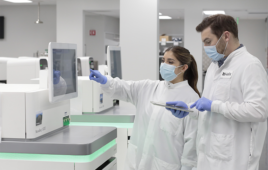
[Photo by Anna Shvets from Pexels]
Clinical breakthroughs for neurodegenerative diseases are rare. The most recent drug to win FDA approval for Alzheimer’s, Namenda (memantine) from AbbVie-acquired Allergan, did so in 2003. And Levodopa, one of the most-effective Parkinson’s therapies, won FDA approval in 1975.
The quest for disease-modifying agents
“There are zero disease-modifying agents for Alzheimer’s or Parkinson’s,” said Dr. Allan Levey, professor and chair of the Emory University neurology department.
For Parkinson’s, drugs can “can reverse symptoms pretty well for many people for many years,” Levey said. But the masking of symptoms can hide the gradual progression of the disease.
While the pharma industry has made considerable progress in recent decades in developing disease-modifying drugs for multiple sclerosis, drug development for Alzheimer’s, Parkinson’s and epilepsy has followed a symptomatic approach.
“What we’re talking about is not focusing on symptoms,” Levey said. “We’re talking about getting at the root causes of the disease and arresting it.”
“With the aging of our population, we still have increasing numbers of Alzheimer’s and Parkinson’s patients with disability. It’s a huge unmet medical need,” said Dr. Jeffrey Gulcher, chief scientific officer of Genuity Science.
A central goal is to use whole-genome sequence data and other’-omic’ data to study the genes that contribute to neurodegenerative disease risk.
Only a limited number of Alzheimer’s or Parkinson’s patients have had their genomes sequenced to date. “And even fewer have had detailed enough clinical data for you to look at severity or rates of progression,” Gulcher said.
Emory University, however, has collected data on large numbers of patients with neurodegenerative diseases. The university possesses detailed clinical data on almost 3,000 Alzheimer’s patients who have consented to genetic testing and other studies.
Bringing structure to chaos
One of the many challenges in understanding neurodegenerative diseases is harmonizing data from diverse populations. Emory University has more than 50,000 patient encounters annually in its neurology clinics. “It’s probably closer to 100,000 if you look at some of our affiliated sites,” Levey said. Documenting neurodegenerative diseases within that environment can be challenging.
“I’ve got the world’s largest group of doctors that work for us that take care of Parkinson’s disease. They’ve discovered breakthrough treatments,” Levey said. “And every one of those 24 or 25 doctors who sees patients documents things in their own way.”
That fact makes it difficult to do simple things such as chart the rate of Parkinson’s or Alzheimer’s over time. “And yet, they’re some of the best doctors in the world. People you’d want to see. They’ve done the examination carefully, but they’re not documenting things in a structured way.”
Emory University began prioritizing structuring data related to Alzheimer’s clinical assessments 15 years ago. “And it’s a goldmine because now we have blood, spinal fluid and brain imaging data,” Levey said. The partnership with Genuity Science further build on that foundation, Levey said. “We’re going to be able to have a real-world population where we can integrate all these data sets.”
As part of the Accelerated Medicines Partnership program with NIH, Emory University has measured proteins for a national consortium of researchers. “We are measuring over 2000 brains now and have 10,000 proteins.”
Integrating the data in a formal research study perspective could give Alzheimer’s disease researchers something akin to the Framingham Heart Study, which led to breakthrough discoveries concerning cardiovascular disease. “An organized long-term study of disease would be extraordinarily valuable because there’s very rigorous data that gets collected in a very consistent manner. Now, over time, so you have longitudinal data. It’s as good as we can do,” Levey said.
A similar problem exists with meta-analyses on neurodegenerative diseases, which achieve a high statistical power by blending study results, but harmonizing data across distinct studies is often tricky, Gulcher said. While large-scale studies for multiple sclerosis (MS), for instance, could shed light on genetic factors linked to the disease, integrating results from different clinical trial collaborators can result in a loss of nuance. Researchers might disagree on how to classify severe MS or a subtype of MS and therefore lump patients with different disease subtypes together under the same umbrella.
“I call it the ‘curse of meta analysis’ where you have 10 different groups that want to pull their data together,” Gulcher said. Many genetic studies using the meta-analysis approach forgo harmonizing clinical data and focus on the top-line diagnosis. “So, you’ll see Alzheimer’s versus controls or Parkinson’s versus controls. Or maybe we’ll have the age of onset Parkinson’s or Alzheimer’s,” Gulcher explained. While it is straightforward to integrate data using such an approach, studies that do so “don’t have all the clinical features, or the rates of progression for those diseases,” Gulcher added. “We think that is important for drug development because you want to make you want to prioritize pathways that drive faster progression of Parkinson’s or Alzheimer’s.”
One answer to the problem is to find a single institution integrating large volumes of detailed data for neurodegenerative disease.
Emory University has studied more than 2,000 brains from Alzheimer’s patients and almost 400 cerebrospinal fluid samples using quantitative proteomics. The proteins and biological processes they have discovered could serve as therapeutic targets for the disease.
“Genetic studies have exploded,” Levey said. “Genetics can help understand risk on an individual basis and begin to unravel the disease mechanisms to identify therapeutic targets.”
Emory’s approach to studying neurodegenerative diseases like Alzheimer’s is rooted in systems biology. “You collect all the data that you can from people who have been well-studied in life who have Alzheimer’s disease, or who died with Alzheimer’s disease and people who didn’t die with Alzheimer’s disease,” Levey said. “You study their genetics. You study the RNA and protein expressed in their brain, and you understand their risk factors and how their memory changed over the course of their life. And then you use advanced mathematical analyses to let the data speak for themselves.”
Filed Under: Genomics/Proteomics, Neurological Disease





Tell Us What You Think!
You must be logged in to post a comment.